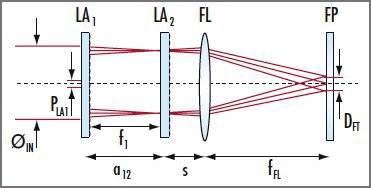Beam homogenization setups typically consist of a pair of square Microlens Arrays and a Plano-Convex (PCX) Lens. The homogenization plane FP is located at one focal length distance ƒFL behind the spherical lens FL. The first array LA1 divides the incident beam into multiple beamlets. The second array LA2, in combination with the spherical lens FL, acts as an array of objective lenses that superimpose the images of each of the beamlets onto the homogenization plane FP.

The dimensions of the beam in the homogenization plane are given by:

The divergence q (half angle) after the homogenization plane is given by:

Design Considerations

- Microlens Pitch: For standard laser beams, the overlay of 9-10 microlenses is usually sufficient to achieve a good flat top uniformity. Consequently, the beam diameter Ω constrains the maximum microlens pitch PLA1 ≤ Ω/3.
- Diffraction Effects: For small microlens apertures and a long focal length, the flat top profile might be distorted by Fresnel diffraction at the lens apertures. Thus for small laser beams, a beam expander and diffuser will typically provide better performance than using microlens arrays with a very small lens pitch.
- Crosstalk: The diameter of the individual beamlets at the second array LA2 must be smaller than the lens pitch to avoid an overfilling of the lens aperture and loss of light. For laser beams with a significant beam divergence, the diameter of the beamlets at the second microlens array scales with the beam divergence.
- Damage: For high-power laser beams, focusing into the material of the second microlens array or the spherical lens must be avoided. An additional diffuser might be used to properly fill the aperture of the second array.
- Divergence: The beam divergence is increased by the beam homogenizer.


![]()
![]()

or view regional numbers
QUOTE TOOL
enter stock numbers to begin
Copyright 2023, Edmund Optics Inc., 101 East Gloucester Pike, Barrington, NJ 08007-1380 USA
California Consumer Privacy Act (CCPA): Do Not Sell or Share My Personal Information
California Transparency in Supply Chains Act